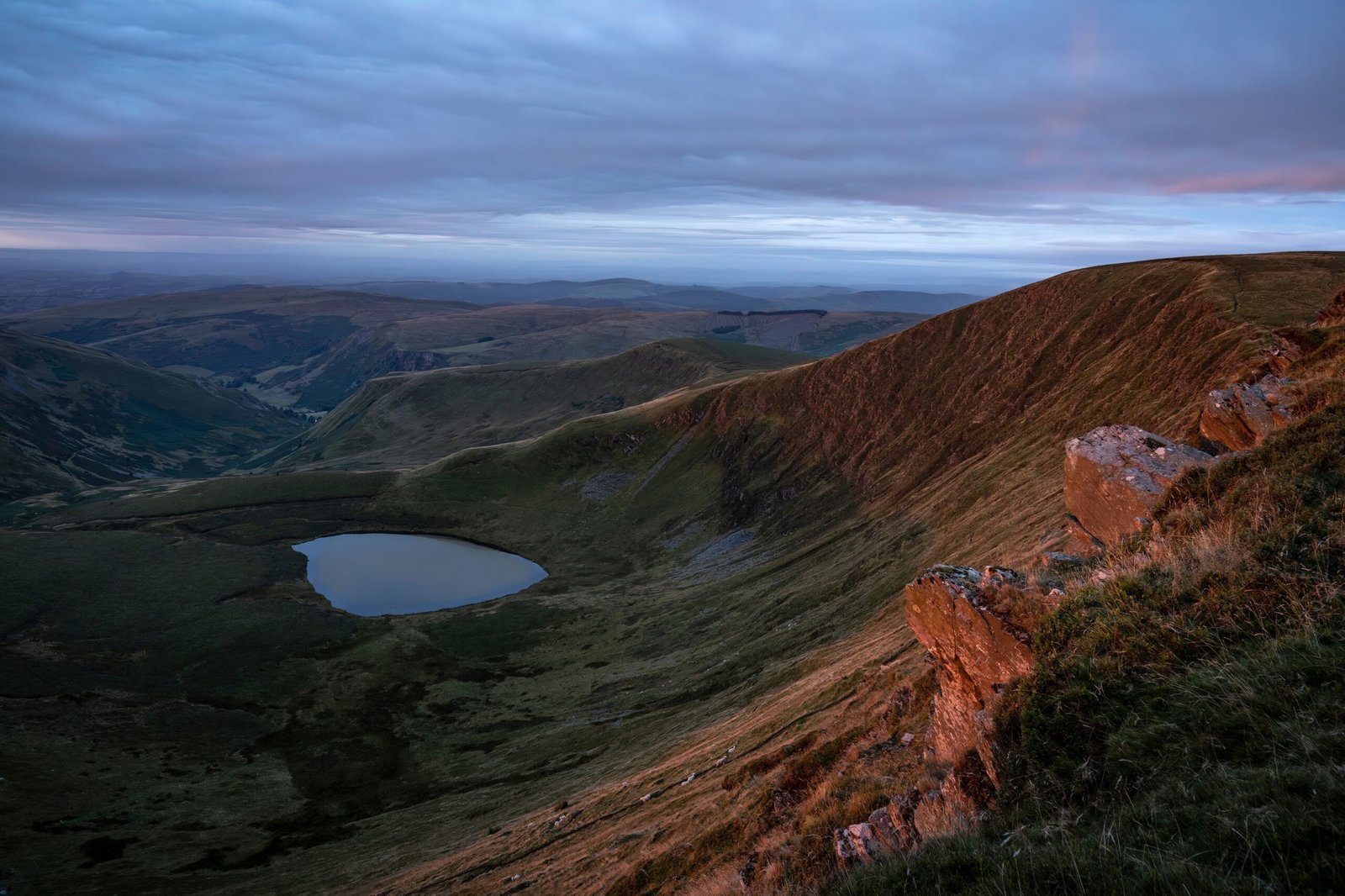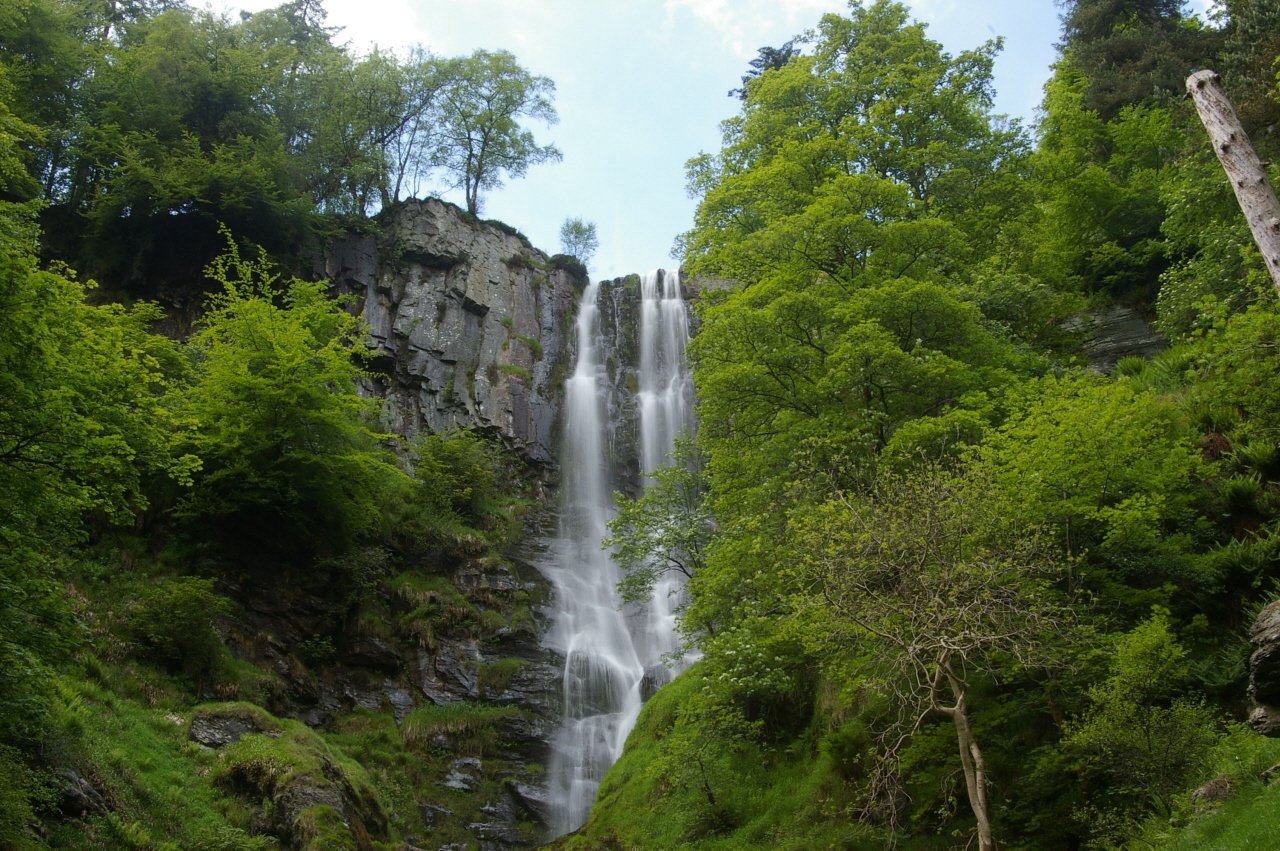Away with the Fairies: A UFO Crash in the Berwyn Mountains?

Once thought to contain the mysterious realm of Annwn, or land of the dead, the Berwyn Mountains lie south and east of Bala but although the highest peak – Cadair Berwyn, at 830 metres – is shorter than some half-dozen Snowdonia mountains this fascinating area, full of wildlife and of stark beauty, is well worth visiting. And rather less full of tourists, there is peace aplenty here, not to mention enigmatic folklore and legends, a number of which strongly suggest the presence of Goddess as the old woman who built and dwells still in her landscape.
There are certainly centuries’ worth of folklore tales about aerial phenomena in the Berwyns, featuring unusual lights on and around the mountains and valleys. Above Pistyll Rhaeadr, near Llanrhaeadr, is Rhos y Beddau (Moor of the Graves), with standing stones, circles, and many burial mounds, not to mention stories of flying dragons. The very interesting Pistyll Rhaeadr website1 has some fascinating ideas, suggesting that the Welsh word for waterfall, Rhaeadr, derives in part from the word “dwr” – water – while the rest suggests Rhea, mother of Zeus… and if she seems a little out of place in a remote Welsh valley, there’s a story explaining how Rhea, Magna Mater (Great Mother) became the madron (patroness) of Roman soldiers, and there was indeed a Roman settlement and fort at the source of the river Rhaeadr, which is a tributary of the Tanat, where Romans grew grapes: Tanat wine* is still produced in several countries previously colonised by Rome.2
There’s more recent folklore too, as any Google search for “Berwyns UFO incident” will confirm, with over 800,000 results. Sometimes known as the “Welsh Roswell”, and centred around Llandrillo, just eight miles from Bala, strange lights were seen and loud explosive noises heard on 23 January 1974, with no immediate explanation available. Some UFOlogists claim that a cover-up took place almost immediately, with Russell Kellett, for example, asserting that there was an “earth-shattering flying saucer crash landing” and suggesting that a secret military operation had taken place on that night.3
Perhaps such a disaster was waiting to happen? Andy Roberts, in his UFO Down! The Berwyn Mountain UFO Crash4, tells of a 1958 children’s science fiction novel by Gavin Gibbons, featuring a UFO landing in the Berwyns, and there have been a number of plane crashes in the area. Roberts also tells of witnesses who reported hearing something like an explosion or rumbling sound, followed by a sort of “rolling” sensation at around 8.30pm on that evening. The police took a lot of calls that night, from as far away as the north coast of Wales and the West Midlands. Fire, ambulance and mountain rescue services were put on standby and RAF Valley in Anglesey sent a search and rescue team, but found no wreckage on the mountain. While no evidence of a plane crash was found, an observatory in Scotland, over 150 miles away, recorded a medium earth tremor here, lasting about one minute, while other locations indicated similar findings of a tremor measuring about 3.5 on the Richter Scale –an intensity that many people would mistake, for example, for a heavy goods vehicle passing nearby. So could a minor earthquake have caused all the odd phenomena?
No-one seems to have come up with a better explanation than one put forward by Dr David Clarke, who wrote the foreword to Andy Roberts’ book – that “at least some of the Berwyn ‘UFOs’ might have been ‘earthlights’, luminescence caused by tectonic stress generated during an earthquake.”5
This theory was actually developed in the 1970s, when Paul Devereux began researching the history and folklore of unusual lights of this kind, believing that geological strain within the earth near seismic faults could produce intense electromagnetic fields, creating glowing bodies of light.6 This is supported by an article in National Geographic which gives examples of common earthquake lights, including bluish flames coming out of the ground at ankle height, orbs of light called ball lightning that can last several minutes, and quick flashes of what looks like lightning, but they actually come out of the ground rather than the sky and can stretch up to 650 feet. We’re also told that in 1988 people saw a bright purple-pink globe of light along the St Lawrence River in Quebec, eleven days before a powerful quake. The explanation given is that when certain kinds of rock are stressed, electrical charges may be released, leading to the light shows. These are pretty rare, which is unfortunate as such phenomena could otherwise help to predict quakes.7
Perhaps this wasn’t the first sighting of Earthlights in the area, Roberts also writes of an event reported in October 1611 where following an earthquake and sightings of “monstrous flaming things” in the sky, a Mrs Penmore went into labour and brought forth three male offspring who had teeth and could speak at birth.8
Returning to the UFO claims, it is certainly true that an MoD investigation uncovered five other reports of objects seen over the UK on 23 January 1974, all a very long way from North Wales. The official version then, according to an article on the BBC News website, is that the earthquake caused a landslide, explaining the loud noises and maybe the lights, while coincidentally a meteor was burning up in the atmosphere at the same time, later disintegrating over Manchester.9 Interestingly, I had not felt particularly suspicious of the official explanations until I read the BBC article! And of course neither these nor the Earthlights theory actually disproves the possibility of a UFO or any other crash.
Maybe some clarification would be useful here – first of all, UFO simply means Unidentified Flying Object and while that seems to be inextricably linked with ideas of aliens in popular culture, the word “unidentified” means just that and they’re certainly not necessarily from outer space! But belief in alien visits to earth is common, a recent study in the US found that 25% of adults believe that these visits have taken place, rising to 45% of people who think there is life on other planets.
I wasn’t in the UK during 1974 but have spoken to local people who remember the event, including one acquaintance of a nurse from the area who went to try to help after hearing the explosion. She apparently still lives here but so many tabloid papers and UFO researchers have misquoted her that she now refuses to talk to the press at all. And quite honestly I think the only decent thing to do is to leave her alone!
Russell Kellett claims that witnesses saw a flying saucer at the side of the road near Llandderfel, with “what looked like an alien” in a pilot suit and five other occupants, around four and a half feet tall. They wore grey uniforms and their heads were the shape now commonly known as “alien greys”.10 Elsewhere in the book there is a whole taxonomy of alien shapes and sizes, including reptilians, shadow people, banshees, little people like elves and of course the White Lady and fairies, and he appears to be suggesting that all these tales derive from past visits by alien craft – a claim I’d turn on its head: people use what is familiar to them to explain the indescribable: sightings from pre-technological dates suggest dragons or fairies, but by the mid 20th century similar observations were interpreted as a “phantom” World War Two bomber. And since space travel began we have UFOs.

The Roman writer Procopius told of a wild and desolate area to which the souls of the dead are conducted and some people have interpreted this as the Berwyns, thought to contain the realm of Annwn. This was ruled over by Gwyn ap Nudd, king of the faery folk, famously defeated in a well-known tale of St Collen (interestingly described as a woman in at least one early Life)**. He – or she – went onto the mountain to confront Gwyn and accepted his invitation to enter the halls but wisely refused food and drink to avoid staying forever. In some versions everything untoward simply faded into the mist, while in others Collen emptied a bottle of holy water over Gwyn.12 Other tales give all this as happening on Glastonbury Tor, but in either case the vision disappeared and Collen was alone on the hillside. His (or her!) adventures weren’t over and a flesh-eating giantess who lived on nearby Bwlch Rhiwfelen was yet to be tackled as she was decimating the local population. The saint managed to chop off her right arm, but she picked it up and used it to beat Collen, so s/he cut off the other arm too before slaying her. Another earth goddess defamed and removed by the Church?

The whole area seems to have been remarkably well-populated by monsters who liked to feast on human flesh, for above the waterfall at Llanrhaeadr is a lake called Llyn Luncaws, where lived a gwybr, a serpent with wings who would fly down to the village and there seize and devour people. A group of villagers walked over the mountains to visit the wise woman of the hills, and she came up with a plan which involved placing iron-spiked collars over a great standing stone, which was then covered by a red sheet. Once the dragon was spotted a fire was lit around the stone and the gwybr promptly attacked what it believed to be a rival, which drove the spikes into its body and killed it. The stone, known as Post Coch (Red Pillar) is still there, near Llanfyllin.
And still there is more: an enormous giant named Berwyn filled up his apron with rocks to build a bridge across the valley near the waterfall, hoping to surprise his two colossal brothers, but he was startled by a cockerel’s crow and dropped the rocks, which lie to this day strewn along the valley floor.14 Stories of aprons full of rocks being dropped are common in Britain, and there’s a similar tale about Barclodiad y Gawres, a burial chamber on Anglesey – the name means “The Giantess’s Apronful”15. As it is usually goddess who creates the landscape I would guess that the Berwyn giants were probably once also female.
I find it difficult to accept that aliens visit us at all, given the lifetimes it would take to travel even from our nearest stellar neighbours. As a lifelong science fiction fan I’m well aware of the remote possibility of faster-than-light travel but can’t help but be surprised that aliens with such advanced knowledge seem not yet to have equalled our stealth technology, not to mention their distressingly frequent crashes! Far more interesting are the many goddesses hidden in the landscape and in myth; nothing unusual in Britain and although our metaphors change over time it is always worth examining folkore and urban legends for those truths that never change.
Geraldine Charles, December 2022
* Spelt “Tannat” today, the grapes originally grew in the foothills of the Pyrenees, rugged country that probably made them suitable for the climate here.
**Which of course, I can’t now find….
- https://www.pistyllrhaeadr.co.uk/celtic-mythology.html accessed 10/11/22
- Ibid
- Russell Kellett, The Berwyn Mountains UFO Cover Up
- Andy Roberts, UFO Down! The Berwyn Mountain UFO Crash, Fortean Words, 2003
- Ibid
- Paul Devereux, Earthlights: Towards an Understanding of the UFO Enigma, Book Club Associates, 1982
- https://www.nationalgeographic.com/science/article/140106-earthquake-lights-earthquake-prediction-geology-science, accessed 9/11/22
- Roberts, op cit
- https://www.bbc.co.uk/news/uk-wales-10863645, accessed 22/11/22
- Kellett, op cit
- Imag: MjolnirPants, CC BY-SA 4.0 <https://creativecommons.org/licenses/by-sa/4.0>, via Wikimedia Commons
- https://www.pistyllrhaeadr.co.uk/berwyns.html, accessed 18/12/22
- Image: MjolnirPants, CC BY-SA 4.0 <https://creativecommons.org/licenses/by-sa/4.0>, via Wikimedia Commons
- https://www.academia.edu/11441112/Three_Legends_of_Llanrhaeadr_ym_Mochnant_Re_Animating_the_Landscape_, accessed 19/12/22
- https://www.anglesey-history.co.uk/places/prehistoric-monuments/Barclodiad-y-Gawres/index.html accessed 19/12/22

